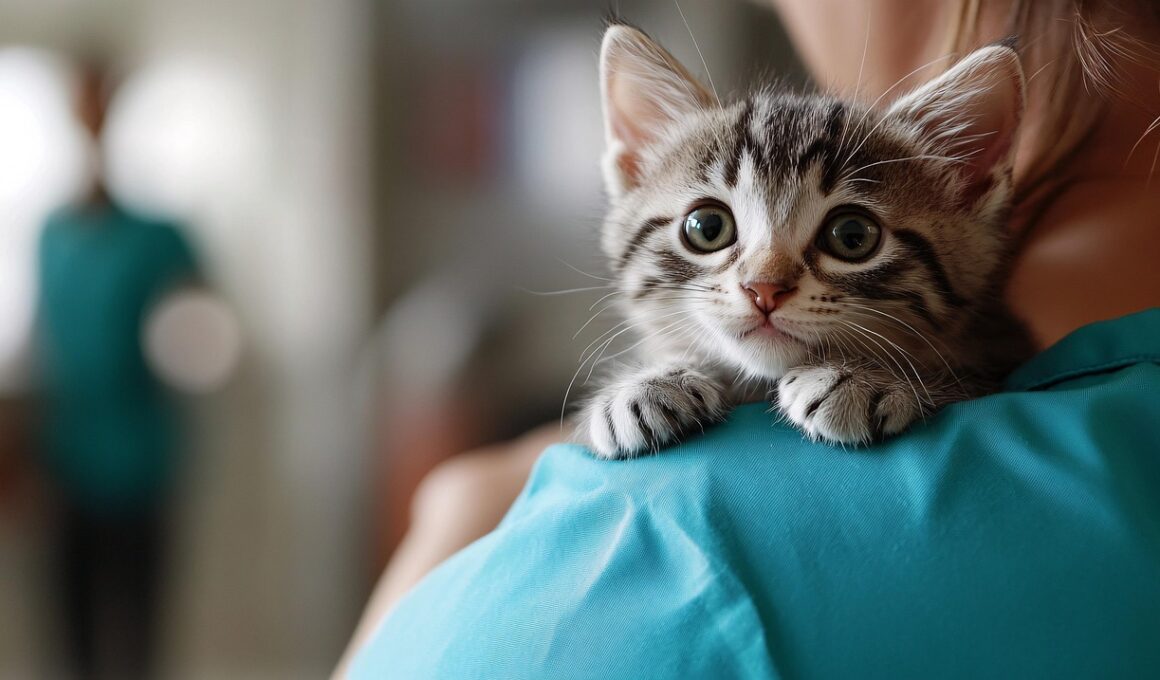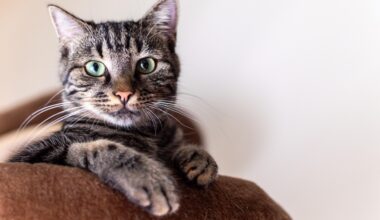How to Use Positive Reinforcement to Diminish Cat Aggression at the Vet
Taking your cat to the vet can often be a challenging experience, especially when faced with aggression. Many feline friends show fear during veterinary visits, leading to hissing or scratching. Understanding this behavior is essential when you want to modify your cat’s reaction. Start by recognizing the signs of anxiety in your cat. You might see body language changes, such as flattened ears or a twitching tail. Providing a familiar and calming environment can be helpful. Before the visit, consider bringing a favorite blanket or toy to make your cat feel safe. This practice of familiarity can ease your pet’s nerves significantly. Additionally, reward your cat with treats when showing gentle behavior at the vet’s office. This positive reinforcement encourages them to associate the vet with positive experiences. Gradually increasing the number of visits, even when not requiring treatment, might also help. Every time your cat shows calmness rather than aggression, give them praise and possibly a treat. Over time, your cat will learn that the vet is not a place to fear and that their behavior can lead to positive outcomes.
One crucial aspect of addressing aggression during vet visits is socialization. Early socialization helps to reduce anxiety and fear in felines. Begin exposing your cat to various environments, people, and sounds. Visiting the vet’s office for non-anxiety-inducing situations helps create a positive association. Consider bringing your cat to the vet just to say hello to the staff or to receive some treats. Each positive interaction solidifies this experience as non-threatening. Gradual exposure to the carrier is also beneficial. Make it a safe space at home where your cat can go without feeling trapped. Leave the carrier available with treats or comfy bedding inside. This step significantly reduces anxiety associated with being placed in the carrier and transported to the vet. Using pheromone sprays designed for cats may also help create a calming atmosphere both at home and during transport. You can find these products at your local pet store or online. The goal is to have your cat see vet visits as a routine part of their life, reducing the chances of extreme aggression due to fear. Slowly desensitize them to the entire process.
Establishing a Command Training Routine
Incorporating command training into your cat’s routine may help manage aggressive behaviors, enhancing your bond while teaching useful skills. Start training commands that are essential for calming your cat during vet visits. Simple commands such as “sit” or “stay” can be taught using treats as a reward. Consistency is key—practice these commands daily through short, engaging sessions. Always reward your cat for complying with cues to reinforce the desired behavior positively. This practice enhances your cat’s self-control and can help redirect aggressive behavior. Employ training aids, such as clickers, to signal when your pet has behaved well. This clear form of communication helps your cat better understand which actions are acceptable. Gradually transition the training environment from home to the carrier or even the car, associating each place with positive actions. Reward them when they are calm and responsive to your commands. This practice encourages your cat to see the entire journey to the vet as a sequence of positive interactions. This proactive approach breaks down aggressive tendencies, fostering a trusting relationship between you and your feline companion.
Creating a positive experience around vet visits often includes regular health check-ups. Regularly scheduled appointments allow your cat to stay familiar with the environment and the staff. These occasions can serve to reinforce all learned positive behaviors through consistent rewards. Ensure your vet understands your intention to manage any aggressive behavior. Communicating openly with your veterinarian allows them to provide support tailored to your cat’s needs. Having a vet who understands your concerns can lead to more effective interventions. Choose a time to visit when the office is less crowded, making the experience less overwhelming for your cat. Despite the inherent stress, remember to remain calm yourself, as cats can pick up on their owners’ emotions. Employ deep-breathing techniques before and during your cat’s visit. As you’re calm, it positively speaks to your feline, which helps alleviate some of their anxiety. Afterward, whether the visit goes smoothly or not, offer a favorite treat as a reward. This reinforces calm behavior and makes future visits more manageable. Gradually, your cat will associate these visits with treats and praise, which diminishes aggression and fosters cooperation.
Using Familiar Scents and Objects
Familiar scents and objects can significantly contribute to easing your cat’s nerves at the vet. Before a vet visit, gently rub a cloth over your cat, then bring that cloth to the vet’s office. Familiar scents make your cat feel at home, reducing anxiety when introduced to new environments. Scattering scents like lavender might have a calming effect on your feline friend, promoting tranquility. Additionally, use your cat’s favorite toys or blankets to provide comfort during waiting times. Create a special kit for excursions that include calming aids, like treats or toy diversions. During the trip, keep these essentials accessible to help soothe your pet. Engaging your cat with their favorite items can distract them from the stressful surroundings. Afterward, reinforce their positive behavior by treating them to their favorite snacks and praising their composed attitude. You might even progress to conditioning your cat to enjoy these outings as part of their routine, focusing on making each experience enjoyable. This step-by-step evolution in their outlook can help significantly decrease aggressive tendencies towards vet visits and improve their overall demeanor.
Finally, patience and consistency are fundamental when utilizing these positive reinforcement techniques. Understand that modifying a cat’s aggressive tendency requires time and numerous visits. Each cat is unique and may respond differently to various approaches. To help, maintain a journal documenting your cat’s progress. This tracking can help identify what seems to work best in alleviating their anxiety or aggression. Whether it’s specific commands, rewards, or calming techniques, logging interactions creates a clearer picture of your cat’s behavioral patterns. Regular breakthroughs may signal your cat is adapting positively to each visit. If your cat’s aggression persists despite your efforts, it might be beneficial to consult with a feline behaviorist. Professional assistance can further aid in adjusting strategies tailored specifically to your cat’s temperament. Emphasize to your pet that their fear and anxiety at the vet can be managed without punishment. Praise and treat them for relaxed behavior, reinforcing a positive experience at the vet. Over the long term, these actions culminate in less aggressive behavior, healthier vet visits, and a happier feline.
Being proactive about your cat’s behavior not only ensures better vet visits but leads to enhanced overall wellbeing. Regular vet visits can help detect health issues early, improving the quality of your cat’s life. This proactive approach makes veterinary care less of a two-way street fraught with anxiety and fear for both cat and owner. As two partners navigating the intricacies of life, learning and practicing together can foster resilience, understanding, and companionship. Remember that each trip to the vet is an opportunity for healing, learning, and bonding. Infusing every visit with positive energy lays the groundwork for a calmer, more emotionally stable feline. Over time, both you and your cat will become more accustomed to the vet environment, turning anxious visits into smooth ones. Commend your pet during and after each visit to reinforce desired behavior and gradually diminish fear-driven aggression. With investment, patience, and understanding, you can create a solid foundation of trust and familiarity with the vet environment, promoting not only good health but also a happy, healthy relationship.
In conclusion, employing positive reinforcement in addressing cat aggression during vet visits can transform the experience for both pet and owner. As you understand your feline’s behavior better, you’ll find more effective ways to help them. This ensures every vet trip fosters trust and makes the situation less daunting. Encouraging peaceful, calm visits benefits both your cat and the veterinary staff. Regular practice of positive reinforcement allows for a more pleasant journey to better health. In retrospect, it’s never too late to start managing your cat’s aggression at the vet. Strengthening the bond you share with your pet through understanding and patience is paramount. By implementing these recommendations, you will progressively enhance your relationship while improving your cat’s comfort at the vet’s office. Ultimately, these methods pave the way for healthier vet visits, a stronger bond, and more positive experiences overall. The cumulative effect fosters an environment where your cat can feel safe and secure, even amidst the unfamiliar setting of a vet. With each positive experience, you’re also nurturing an understanding that will last, leading to successful vet visits and happier cats.


